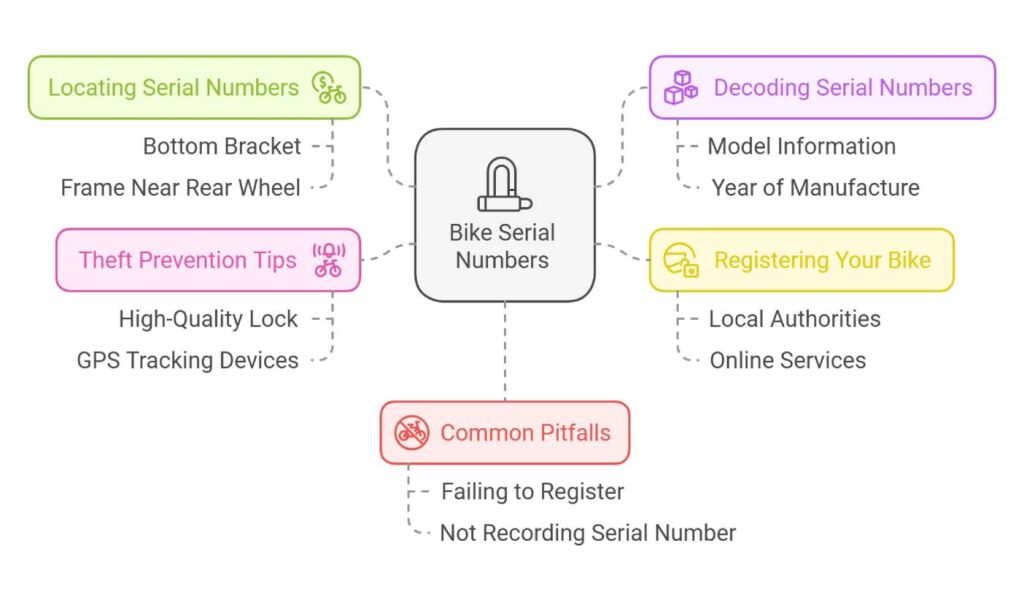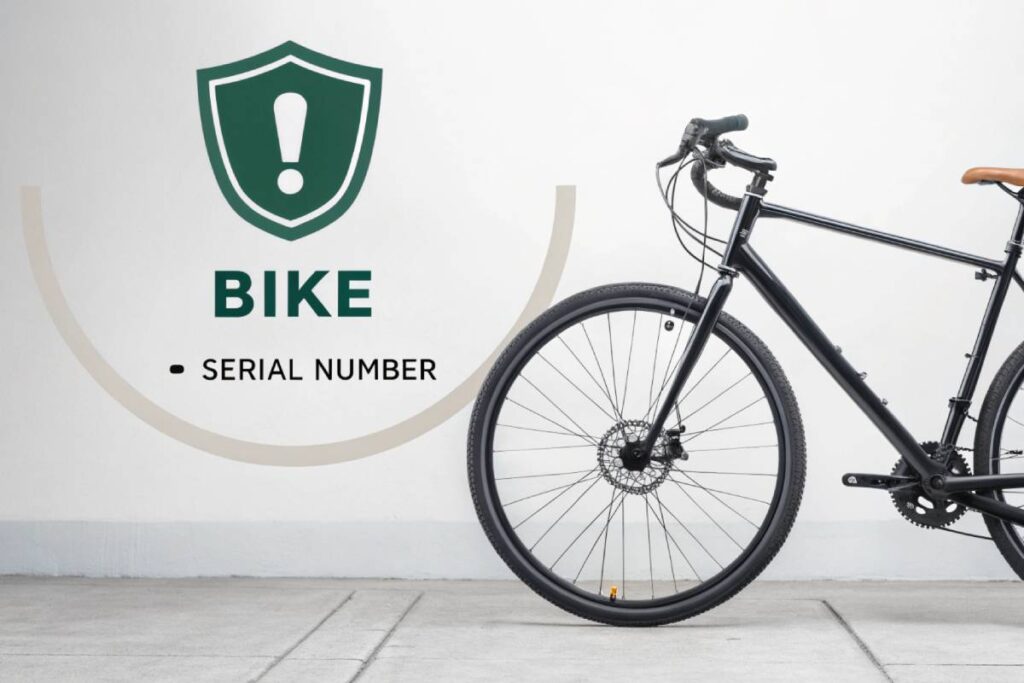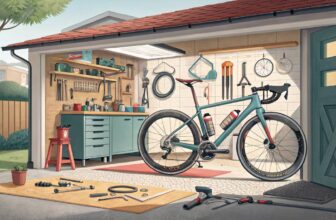Have you ever wondered what keeps your bike’s identity intact amidst countless two-wheelers on the road? Enter the bike serial number—a seemingly simple string of digits with immense power.
Whether you’re a seasoned cyclist or just pedaling your first ride, understanding your bike’s serial number is crucial for proof of ownership, theft prevention, and warranty claims.
Dive into our comprehensive guide to unveil the truth behind bike serial number checks and ride confidently, knowing your prized possession is safeguarded every mile.

Understanding Bike Serial Numbers
Bike serial numbers aren’t flashy, but boy, are they essential. Think of them as your bicycle’s social security number. Below, you’ll see why these little digits hold so much weight and exactly where you can spot them on your ride.
Pick Up on Why They Matter
A bike’s serial number is like its VIP pass crafted by the manufacturer. This unique combo of numbers and letters helps with, let’s say, keeping track of the parts and ensuring the bike’s identity in the mix of two-wheelers. Most of the time, it even gives off hints about when it was born—the year and month—followed by a unique ID code for your bike baby.
Here’s why these numbers are a big deal:
- You Own It, You Prove It: In case of disputes—like insurance tossing questions your way—a serial number can be your star witness. It helps lock in that ownership status.
- Stealing it Back: If your bike gets swiped (touch wood!), this number helps bring it back home, as cops can match it with lost-and-found items.
- Warranty and Whatnot: Got a manufacturing hiccup? Serial numbers are usually your ticket to get that sorted with warranties.
And when it comes to registering with places like Bike Index, Bike Register, and what’s that? Oh, Project 529, you’ll need these numbers for sure. They’ll think it’s super cool you’re lining up your bike for protection.
Spotting the Serial Number
So, where’s your bike’s little number hiding? Knowing this helps you for all the good reasons we just talked about. They’re usually stamped in plain sight—well, sort of. Here’s where they usually hang out:
- Bottom Bracket Shell: Peek under the part where the pedals hang out. It’s a popular spot.
- Head Tube: Follow the handlebar down, and you might just find it there.
- Rear Dropout: Check around the back wheel. Sometimes, they hide here.
- Seat Tube: For brainy brands like TREK, look around the bottom of where your seat post slots in.
And because we all love a good table, here’s a cheat sheet for you:
| Bike Brand | Look Here for the Number |
|---|---|
| General | Under the Bottom Bracket |
| TREK | Bottom Bracket Shell, Lower End of Seat Tube |
| Specialized | Head Tube |
| Giant | Rear Dropout |
Fessing up about your bike and its digits ensures you can secure that shiny ride against theft, get it signed up properly, and make sure all things warranty are in check. If you’re from the serious gang wanting to learn about theft protection, dig into our guide on that.
Thinking about adding another bike to your collection, or just starting out? Cruise through our bike price guide and where to buy bikes section for the full scoop.
Bike Serial Numbers for Identification
Bike serial numbers are like the social security numbers of the bicycle world. They help in spotting and keeping tabs on bikes which is, super handy for people buying their first bike, those sprucing up to new rides, and everyone else wanting to make sure their bikes aren’t stolen or fake.
“A bike’s serial number is its unique fingerprint, essential for proving ownership and ensuring its safe return if stolen.” – Cycling Expert Journal
Unique Characteristics
Just like a fingerprint, every bike gets its own serial number, or as some call it, the bike frame number. These numbers, usually a string of seven to ten digits, are used to keep stock of bikes and ensure the right parts are matched up. And, most importantly, they can prove you own the bike, making it easier to get it back if it gets snatched.
These serial numbers are usually carved into the bike’s frame. If you’re searching, the first place to check is under the bottom bracket—where the pedals attach. Other spots to look include the head tube or the rear dropout.
Knowing about these characteristics is key to making sure a bike’s legit. Having the serial number handy means quick identification if your bike ever goes missing.
Decoding the Serial Number
Cracking open a bike’s serial number can reveal its secrets—like when it was made and its unique code. While the serial number layout can differ from one bike brand to another, they usually have a similar setup.
For example, take a serial number like “Y17M08B12345”. This might be broken down as follows:
- Y17: Made in the year 2017.
- M08: Made in August.
- B12345: Unique code for this exact bike.
Each bike brand might have its own way of structuring serial numbers, but they generally aren’t too far off. It’s smart to check out the manufacturer’s guide or look up resources for decoding accurately.
Here’s a simple table showing how serial numbers can be interpreted:
| Serial Number Example | Interpretation |
|---|---|
| A20B07C54321 | Year: 2020, Month: July, Unique ID: C54321 |
| B19M02X67890 | Year: 2019, Month: February, Unique ID: X67890 |
| T21D11Q10101 | Year: 2021, Month: November, Unique ID: Q10101 |
For more info on identifying and buying bikes, check out guides on used bike inspection, bike component comparison, and bike registration.
Knowing how to crack your bike’s serial number helps in figuring out its backstory and ensuring you’re buying from a legit seller. This is especially useful for parents buying for family, feature comparers, and brand investigators. Having this info is crucial for the bike theft protection and dealing with any counterfeit bike troubles.
Sure, let’s take those ideas and make ’em shine with a little extra sparkle and a dash of humor where it counts. Here we go:
Role of Bike Serial Numbers in Theft Prevention
Bike serial numbers are the unsung heroes in the world of keeping your beloved two-wheeler from going on an unscheduled joyride with a thief. They’re like the secret agents of the bike world, making sure your ride has a fighting chance of coming back to you.

Recovering Stolen Bikes
Think of serial numbers as your bike’s social security number. When your bike is swiped, that serial helps the police play detective. They punch those digits into their system, and if your bike shows up bingo! It’s proof your wheels have been nabbed.
Here’s the breakdown of the “come-back-please” process:
- Serial Number Reporting: Tell the cops the secret code, a.k.a, your bike’s serial number, when reporting that it’s missing.
- Database Matching: Police go fishing for a match with their list of recovered bikes.
- Owner Verification: They call you up if they find your bike, and you and ol’ faithful can be reunited.
Make sure that your serial number is crystal clear and where you can actually read it. Need more handy tips? Check out our bike registration guide.
Registering Your Bike
Jumping on a registration from the get-go hikes up the odds of getting your ride back if it takes off without you. Services like Bike Index, Bike Register, and Project 529 are great places to lock in all that serial number goodness.
Here’s how you can register:
- Locate the Serial Number: Peek under the bike’s stomach, aka the bottom bracket shell, or the seat tube’s backside.
- Register with a Service: Toss your serial number and deets to the chosen registration service like Bike Index, Bike Register, or Project 529.
- Update as Necessary: Keep the info fresh, especially if you change gears – as in ownership or nifty tweaks.
Having your bike on these lists acts like a deterrent to the bad guys because fencing a stolen bike becomes a nightmare. So, don’t skip it when it comes to bike theft protection.
Oh, and if you’re buying a new ride, double-check the serial number matches up with any paperwork. Don’t fall for any scammers out there. For a foolproof buying experience, scope out our page on fake bike reviews.
| Registration Scheme | What’s Cool | Link |
|---|---|---|
| Bike Index | Free to join, why not? | Visit Site |
| Bike Register | One-time sign-up | Visit Site |
| Project 529 | Handy phone app at your fingertips | Visit Site |
Getting your bike registered is like outfitting it with a “back-off, thief!” shield, making it tougher for thieves to find new owners for their loot.
For even more tips, tricks, and tales of bike registration and buying, swing by our buying guides corner.
“Serial numbers transform your bike from just another ride to a traceable asset, deterring potential thieves.” – Bike Security Specialist
Making Sure It’s Real
Checking if a bike is the real deal isn’t just a one-step process. At the heart of this investigation is the bike’s serial number. Let’s dive into why these digits matter so much when sniffing out scams and spotting fake goods.
Catching the Fakes
Think of bike serial numbers as the fingerprint of a bicycle. They help spot shady dealings and verify a bike’s authenticity. Every bike rolls out of the factory with its own unique number. By checking this number, you can spot any fishy business—like cloning—where the same number pops up on more than one bike. That’s a huge red flag for counterfeiting.
When checking out a bike, always cross-reference its serial number with the manufacturer’s records. You don’t want to end up with a hot or fake ride. For peace of mind, running a serial number check will help bring any cloned numbers to light. Sneaky folks sometimes slap a proper number on stolen bikes to cover their tracks, so make sure everything lines up with the registration papers.
Fake Stuff Alert
Sadly, the bike world isn’t immune to knockoffs. This means buyers must keep their eyes peeled. Serial numbers hold the key to telling legit bikes from imposters. If a bike’s price seems too good to be true, double-check its serial number to avoid getting duped.
Real bikes have serial numbers that match up perfectly with what’s on file with the manufacturer. If there’s no serial number or it looks like a five-year-old carved it, chances are it’s a phony. Look out for numbers that don’t match or look super sketchy.
Here’s a quick look at what separates the real rides from the fakes:
| What You’re Checking | Real Bike | Fake Bike |
|---|---|---|
| Serial Number | One-of-a-Kind | Repeated or Gone |
| Papers | Match Serial Number | Don’t Match Up |
Keeping an eye on these details is key to making sure your new wheels aren’t a scam. For more tips on not getting tricked, check out our guide on phony bike reviews.
By sticking to these simple checks, buyers can dodge scams and ensure they’re getting a bona fide bike. For more handy bike buying advice, like where to score bikes or how to weigh bike options, our resources are at your service.
Proof of Ownership
Making sure your bike is properly identified and you can prove it’s yours is super important. Whether you’re dealing with getting your stolen bike back or claiming a warranty, that serial number on your bike is like your secret weapon.
Serial Numbers in Ownership Proof
Think of your bike’s serial number like its fingerprint. It’s a one-of-a-kind mark that the manufacturer stamps onto the bike. Usually, you can find it somewhere on the bike frame, and it tells you things like when the bike was made and gives you a unique ID. If your bike decides to run away from home (a.k.a. get stolen), having that number noted down makes it way easier to bring it back.
| Why You Should Know Your Bike’s Serial Number |
|---|
| Boosts chances of getting it back from thieves |
| Helps match up parts and inventory |
| Acts as proof that it’s really your bike if it’s stolen |
Unbelievably, more than 80% of cyclists don’t know their bike’s serial number, which pretty much drops their chances of finding it again if it gets nicked. It’s smart to find and register your bike’s serial number with a bike registry. This way, if your bike goes on an adventure without you, there’s a better chance you’ll meet again.
Warranties and Ownership Details
If your bike has a hiccup and needs a repair, many manufacturers will want to know that serial number. Why? Because it proves your bike is genuine and matches up with the sale records. Trek, for instance, likes to stamp their serial number on the bottom bracket shell or at the lower end of the seat tube.
| Where to Look for Your Bike’s Serial Numbers |
|---|
| Bottom bracket shell |
| Lower end of the seat tube |
Sales receipts can sometimes omit or misread the serial number due to human error (Vintage Trek). So, always double-check the number on your bike and keep a record.
If you want more info on warranties and ownership details, check out our bike warranty guide. It’s packed with tips on how to keep your bike’s warranty in check and make sure you’re always ready to prove your bike is yours.
Bike Serial Numbers for Law Enforcement
Aiding Police Investigations
Let’s talk about something super important for bike lovers. If your bike ends up in the wrong hands, bike serial numbers are your best friend. These numbers are like DNA for bikes, helping cops trace that missing bike back to you. So, it’s a big deal for bike owners to jot down these digits and register with folks like Bike Index, Bike Register, or Project 529 who are all about getting your wheels back if they’re swiped.
Here’s a shocker—80% of bikers can’t say their bike’s serial number if you asked them. That makes finding a stolen bike like searching for a needle in a haystack. Here’s a tip: find that secret code on your bike and register it. This gives detectives the inside scoop to help recover your ride and reconnect it to you.
Fraud Detection
Now, on to the sneaky stuff—fraud. Thieves like to play dress-up with bikes, slapping a legit serial number onto a stolen ride. Makes the detective work trickier, right? If you’re buying a used bike, you gotta make sure those serial numbers line up on the bike and on all paperwork.
Doing a deep dive into a serial number won’t just tell you where the bike’s been, it spills if it’s been part of any shady business. This helps both you and the cops confirm if that shiny bike is the real deal or a wolf in sheep’s clothing.
| Fraud Detection Stuff |
|---|
| Serial number makeover |
| Paperwork discrepancies |
| Theft history check |
| Real or not verification |
For everyone eyeing a new (or new-to-you) bike, knowing the ropes about a bike serial number check is crucial. Peek at our used bike inspection guide, so you don’t get caught out and keep your buying game strong.
Being cautious and clued-up doesn’t just protect you—it helps law enforcement nab thieves and fraudsters. Plus, this effort keeps the cycling community safer and more honest. Prefer to dig into bike details? Scoot on over to our handy bike price guide and other cool resources for all your bike-buying questions.
Limitations of Bike Serial Numbers
Bicycle serial numbers can be as elusive as Bigfoot, playing tag in the woods. While they’re key in nabbing a stolen bike or reuniting it with its owner, they come with their little quirks. Knowing what might trip you up can be your ticket to smarter bike buying and registration.
Reliability for Bike Identification
Serial numbers are your bike’s ID badge, connecting it back to you. But, there’s always a bit of a hitch.
- Inconsistent Formats: Imagine trying to read a book where every author has their own weird font. Some bike makers go numeric, others mix in letters, leaving folks like us to scratch our heads. Trek, for example, used straightforward numbers for Japanese frames but swirled in alphabets for Taiwanese ones. Good luck sorting that out!
- Hard-to-Spot Locations: Manufacturers just love to hide these critical numbers in dingy corners, like the bottom bracket or down on the seat tube. As time and grime do their thing, spotting these digits becomes a game – the bad kind.
- Recording Slip-Ups: Remember playing a game of “telephone” as a kid? That’s what happens when someone records your serial number wrong on the sales slip, which can mess with warranty claims or theft reports.
Drawbacks in Information Identification
Serial numbers are a great starting point in cracking bike mysteries, but often, they’re like a map with just the ‘X’ marked and the pirate treasure dug elsewhere.
- Minimal Data Insight: These digits tell you only so much. No juicy details about your bike’s top speed or if your uncle’s nephew forgot to lube it last year.
- Spotty Registration: A serial number is only as good as the paper it’s registered on. But let’s face it, many bike owners skip this step, making the numbers as helpful as a screen door on a submarine when your bike goes astray.
- Fiddling and Fraud: Shady characters might scrape off or juggle those numbers. There are laws, sure, but they still find loopholes, leaving our faith in numbers a bit dented.
- Database Disconnect: Different places have their own lists for stolen bikes. Without a global unified system, tracking can be kind of like chasing shadows.
| Limitation | Description |
|---|---|
| Inconsistent Formats | Different strokes for different manufacturers lead to decoding headaches |
| Hard-to-Spot Locations | Numbers hidden where only Sherlock Holmes would look |
| Recording Slip-Ups | Potential mismatches between receipts and actual bike numbers |
| Minimal Data Insight | Serial numbers offer sparse info on bike details |
| Spotty Registration | Effectiveness depends wholly on owner diligence |
| Fiddling and Fraud | Risks of altering or removing serial numbers by sneaky folks |
| Database Disconnect | Lack of harmony among the stolen bike databases |
To handle these hiccups, always jot down your bike’s serial number like it’s a winning lottery ticket. Double-check it before buying your two-wheeled treasure and register ASAP to keep it safe. For guidance, check out our bike registration guide.
Learn about other bike buying blunders to dodge headaches on your next purchase. Compare bike brands and sweep through our tips for new and used bikes to ride away with the best pick.
Serial Numbers for Property Identification
Bike serial numbers are your wheels’ secret weapon. They’re the unsung heroes when it comes to bike theft and helping you get back what’s yours if someone makes off with your ride. Here’s why serial numbers are a big deal in tracking down lost bikes and figuring out whose bike is whose.
Recovering Stolen Property
Got your bike swiped? A lot of times, the only shot at getting it back is knowing that serial number by heart. Pop it onto platforms like Bike Index, Bike Register, or Project 529, and you’ll be upping your odds. If the police find your bike chilling in a thief’s lair, that tiny number proves it’s yours—plain and simple.
Steps to Up Your Recovery Game:
- Find That Number: Check under the bike’s bottom bracket, but it could sneak around on the head tube or the rear dropout.
- Get It Registered: Sign up with Bike Index, Bike Register, or Project 529.
- Snap and Save: Take a picture of the number, and shoot it to yourself in an email so you’ll always have it handy. For more tips, swing by our bike registration guide.
Identification Process
When it comes to saying which bike is yours, that serial number’s the gold ticket. Sadly, over 80% of cyclists don’t know their number, which makes finding a stolen bike tougher. Here’s how you can stay ahead:
Serial Number Know-How:
- Find the Number: Usually hiding on the bottom bracket but could be on other hidden spots on the frame.
- Check the Digits: Use it to check your bike’s backstory. Your bike’s maker might be able to confirm its pedigree.
- Lock It in a Registry: Pop it into Bike Index, Bike Register, or Project 529 to give the cops a helping hand.
Where the Serial Number Likes to Hang Out:
| Place | What To Look For |
|---|---|
| Bottom Bracket | Underneath where the pedals live |
| Head Tube | The bit of frame up front near the bars |
| Rear Dropout | Back on the frame near where the back wheel sits |
If you’re buying a new or second-hand ride, poking around to compare bike specs against the serial number makes sure you’re not getting bamboozled. This habit keeps shady deals at bay. For more tips, scope out our piece on fake bike reviews.
Stick with these tricks and tools, and you’ll not only guard against theft but crank up the odds of seeing your bike again. Keep those wheels turning smoothly and enjoy the ride!
Conclusion
Understanding your bike’s serial number is more than just a mundane task—it’s a vital aspect of responsible bike ownership. These unique identifiers not only affirm your ownership but also play a critical role in safeguarding your bike against theft and fraud.
By knowing where to locate your serial number and how to decode it, you empower yourself with the knowledge to verify authenticity and ensure you’re investing in a genuine product.
Registering your bike with trusted services like Bike Index or Project 529 can significantly enhance the chances of recovering your bike if it ever goes missing. However, it’s equally important to be aware of the limitations, such as inconsistent formats and potential for fraud, and take proactive steps to mitigate these risks.
Embrace these practices to enjoy a worry-free cycling experience, knowing that your bike is protected and that you’re part of a community committed to keeping our rides safe and authentic. Stay informed, stay secure, and keep those wheels turning smoothly!
FAQs
What is a bike’s serial number?
A bike serial number is a unique combination of letters and numbers assigned by the manufacturer to identify each individual bicycle.
Where can I find my bike’s serial number?
Common locations include the bottom bracket shell, head tube, rear dropout, and seat tube. Refer to your bike’s manual for specific locations.
How does registering my bike’s serial number help prevent theft?
Registering your serial number with services like Bike Index increases the likelihood of recovering your bike if it’s stolen, as it can be easily identified.
Can serial numbers be changed or removed?
While it’s possible, altering or removing a serial number is illegal and considered fraudulent. Always ensure your bike’s serial number remains intact.
What should I do if my bike is stolen?
Report the theft to the police with your bike’s serial number and register the theft with online databases like Bike Register or Project 529.
Final Thoughts
Protecting your bike goes beyond securing it with a lock; understanding and utilizing its serial number is a pivotal step in ensuring its safety and authenticity. By taking the time to locate, decode, and register your bike’s serial number, you not only assert ownership but also equip yourself with the tools needed to recover your bike in case of theft.
Remember, knowledge is power—knowing where your serial number is and how to use it effectively can save you from potential headaches. Additionally, staying informed about the limitations of serial numbers helps you take comprehensive measures to safeguard your investment.
Embrace these practices as part of your regular bike maintenance routine and join a community that promotes secure and honest cycling. Whether you’re a casual rider or a dedicated cyclist, these steps ensure that your journey remains smooth and worry-free.
Keep pedaling with peace of mind, knowing your bike is protected every step of the way.
Key Tips
- Locate Your Serial Number Early: Familiarize yourself with where your bike’s serial number is located as soon as you purchase it.
- Register Promptly: Sign up with reputable bike registries immediately to enhance recovery chances.
- Keep Records Safe: Store your bike’s serial number in multiple secure places, including digital backups.
- Verify Before Buying: Always check the serial number of used bikes against manufacturer records to avoid scams.
- Regularly Update Registration: If you make significant changes to your bike or ownership, update your registration details accordingly.
Recommended Biking Products and Accessories
- Bike Locks
- The Best Bike Lock U-Lock
- Heavy-Duty Chain Lock
- Bike Registries
- Bike Index Membership
- Project 529 Premium
- Smartphone Apps
- Bike Register App
- Project 529 Mobile
- Maintenance Tools
- Multi-Tool for Bikes
- Portable Bike Pump
- Safety Gear
- High-Visibility Lights
- Helmet with Integrated Camera
- Storage Solutions
- Bike Covers
- Secure Bike Racks
- Warranty Services
- Extended Warranty Plans
- Bike Insurance
- Authentication Tools
- Serial Number Engraving Tools
- Verification Services
By equipping yourself with these products and utilizing the strategies outlined in our guide, you can ensure your bike remains secure, authentic, and in top condition for all your cycling adventures.




